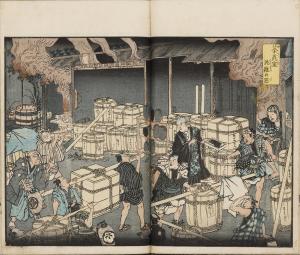Chronicle of the Cholera Outbreak of Fall 1858 (Ansei Uma no Aki Korori Ryukoki)
Preface by Kinōroka 1858(Ansei 5) Tokyo Shiryō Collection 771-8
The outbreak of cholera that began in Nagasaki in June 1858 spread to Edo by July of the same year. This book chronicles the situation in Edo at the time of the outbreak.
The first outbreak of cholera in Japan occurred in 1822. Cholera caused death within three days after symptoms appeared, which led to it being known as mikka korori or "fall down in three days," korori being a play on korera, the Japanese word for cholera. The 1822 outbreak was centered on West Japan, and did not affect Edo. However, a later outbreak that began in Nagasaki in June 1858 spread to Edo by July of the same year. This book chronicles the situation in Edo at the time of the outbreak.
The illustration here shows a crematorium overflowing with caskets of the deceased awaiting cremation. It is estimated that there were around 30,000 fatalities in Edo during this outbreak, and neither burial nor cremation services could keep up with the demand, so caskets were lined up on the roadside around crematoriums. Filled with anxiety, the townsfolk of Edo turned to religion to ward off the disease. They put their faith in objects such as the leaves of the Japanese aralia tree, charms bearing poems of the Mimosuso River (another name for the Isuzu River that runs through Ise Shrine), and charred garlic. There were repeated outbreaks of cholera every few years in Edo from 1862 onward.


